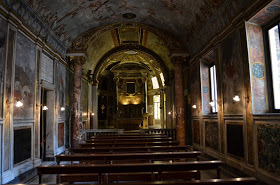Chiesa di Sant Aniceto, Palazzo Altemps, Rome, 1614
How? and Why?
How does music interact with visual perception of architectural space to engender a feeling of the transcendent? What aspect of the acoustics of sacred spaces induces spiritual feelings? Is it measurable? Is it replicable?
Why can music cause people to feel transported? Why do some of us, when certain music is played, and when we are in certain architectural structures, feel like we are in the presence of majesty, of something overpowering, awe inspiring, reverential? Music and architecture share roles in evoking spirituality. Music is transitory, ephemeral, and intangible, it affects our aesthetic feeling. Architecture is voluminous, stationary, and material. At times, it alters our sense of relative size. Somehow, in their interplay, a sense of the spiritual sometimes emerges.
Our inquiry into the interaction of music, architecture and human spiritual feeling involves coordinating four activities.
Capture the acoustic signatures of sacred spaces; Building computational models of them, and mathematically analyzing them to determine commonalities.
Experimentally determine the nature of the interaction between acoustics, architectural space, and human judgment and feeling. In four experiments, we will test subjects first in sacred spaces recreated in virtual reality, and subsequently in physical spaces whose acoustics are manipulated in real-time.
We hypothesize that the cause is a sensory mismatch between auditory estimates of size and shape and visual estimates based on observing the architectural space from whence the sound and music is heard.
Finally, we will observe and test how musicians are affected by the acoustics of the sacred spaces for which they compose and in which they perform, specifically, how they adapt in subtle ways to the resonance, reverberation and reflectance that make them unique.
Hypotheses
Many sacred sites create auditory impressions of size and volume that confound or contradict our visual impressions due to acoustic-visual interactions that subvert listeners’ abilities to localize sounds, to judge the distance from source to ear, to identify the number of signals that comprise a sound, and to unambiguously segment and discretize sound. The resulting sensory integration confusion can create a feeling of ethereality where space seems measureless, indefinite. When certain types of music are heard in these measureless spaces they may evoke a transcendent quality.
Underlying assumptions
